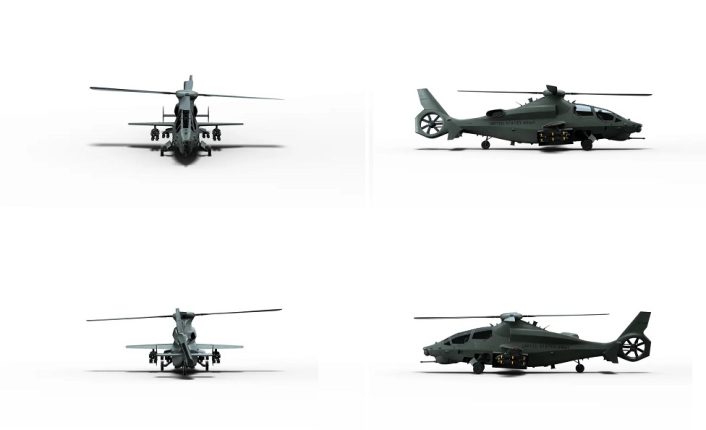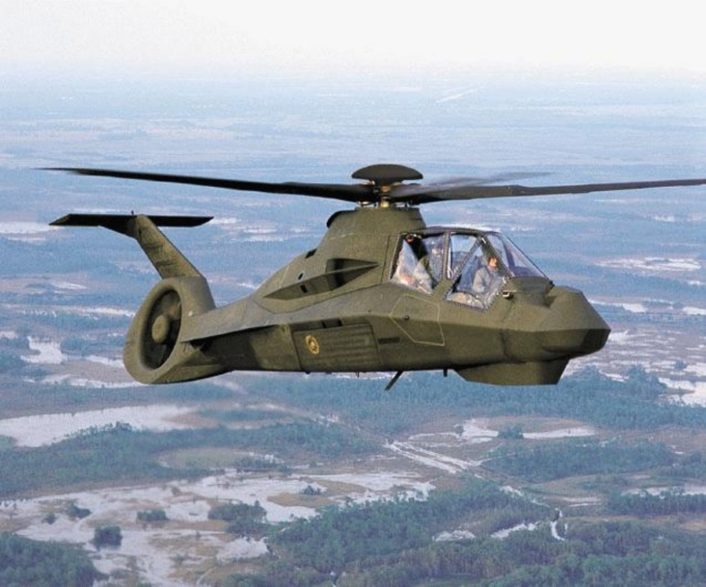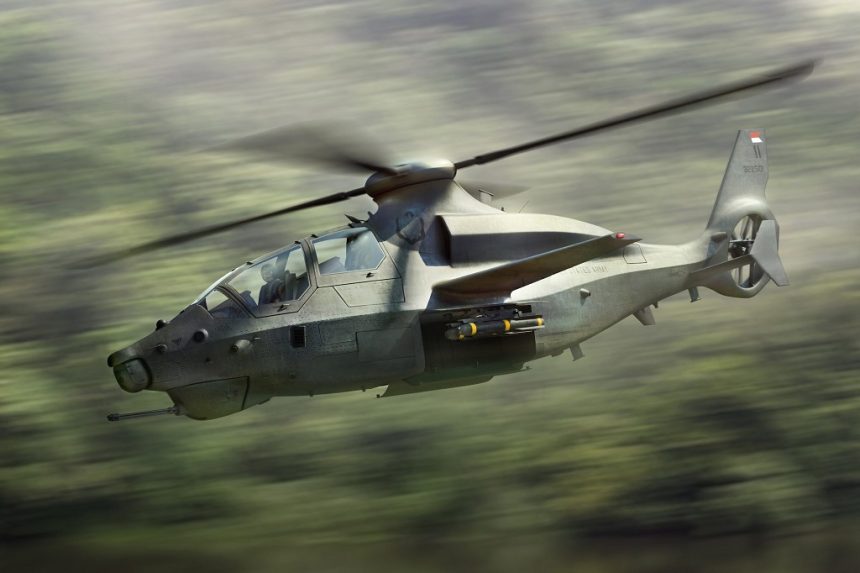The new helicopter is Bell’s pitch for the U.S. Army’s Future Attack Reconnaissance Aircraft.
Bell Helicopters announced on October 2, 2019 its new Bell 360 Invictus for the U.S. Army’s Future Attack Reconnaissance Aircraft (FARA) Competitive Prototype program. FARA is intended to fill the capability gap left by the retirement of the Bell OH-58D Kiowa Warrior. Currently this capability is being replaced by manned-unmanned teams of AH-64E Apache Guardian helicopters and RQ-7B Shadow Unmanned Aerial Systems.
The U.S. Army provided both mandatory and desired requirements for the program. The mandatory requirements include the integration of equipment provided by the government (specifically the engine, gun and rocket launcher), a minimum target speed, a specific target gross weight, an affordability goal and a maximum rotor diameter of 40 foot. The range, endurance and payload are categorized as desired requirements.
Keith Flail, vice president of Advanced Vertical Lift Systems at Bell, said: “Bell is committed to providing the U.S. Army with the most affordable, most sustainable, least complex, and lowest risk solution among the potential FARA configurations, while meeting all requirements”.
In the official news statement released by the company, the low risk solution is attributed to the use of proven technologies, of which the main one is the rotor, a scaled down version of the articulated five-blade rotor designed for the Bell 525 Relentless, a super-medium-lift twin-engine commercial helicopter for the off-shore market. According to Bell, the 525 reached speeds in excess of 200 Knots True Air Speed (KTAS) during flight testing. The four-blade rotor of the Invictus should reach more than 185 kts, while the Army’s requirement is for a cruise speed of at least 180 kts.

The helicopter has a stub wing that, according to Frank Lazzara, director of Advanced Vertical Systems Sales and Strategy at Bell, could provide up to 50% of lift when the aircraft reaches the cruise speed, reducing the rotor lift demand and translating more power into forward movement.
Another feature that will help the helicopter reach high speeds is its streamlined profile, internal weapon bays, main rotor aerodynamic shroud, retractable landing gear and a ducted tail rotor, which is also slightly canted. This design is highly reminiscent of the Boeing/Sikorsky RAH-66 Comanche, the stealth armed reconnaissance helicopter designed in the 1980s to replace the OH-6 Cayuse and the OH-58 Kiowa and to designate targets for the AH-64 Apache. The program was canceled in 2004 with only two flying prototypes built.
Stealth, however, is not the reason of the design adopted for the Invictus. “Everything we have done has been focused on how do you keep the lowest drag possible on the aircraft, so we don’t have to add exotic solutions to the aircraft the meet the requirements to get the speeds that you need for the FARA program”, said Flail during the presentation.
The helicopter will be powered by the Improved Turbine Engine Program (ITEP) engine, thanks to a contract awarded to General Electric Aviation in February 2019. The new engine, called T901, will also replace the T700 engines, used by both the UH-60 Black Hawk and the AH-64 Apache, starting from 2026. Unlike the Comanche, the Invictus uses a single engine, but with double the power, mounted asymmetrically on the left side of the rotor, while its exhaust is located on the right-hand side.
Other than the engine, Lazzara said the helicopter has an undisclosed patent pending Supplemental Power Unit that will provide additional horsepower when extra speed is needed during forward flight. With the aforementioned features, the 360 Invictus should be capable, according to Bell, of a cruise speed in excess of 185 KTAS, a combat radius of 135 nautical miles with over 90 minutes of time on station, a 1400 lbs payload and a Hover Out of Ground Effect (HOGE) at 4000ft at 95°F (35°C).
The Invictus is controlled via a fly-by-wire system which will perform automatic trim during forward flight to provide the best drag configuration, reducing the pilot workload and adding also provision for future autonomous flight capabilities. Interestingly, Bell didn’t choose Lockheed Martin for the avionics, as done for the V-280 Valor tiltrotor, but instead chose Collins Aerospace, the same company that provides the avionics for the A/MH-6M Littlebirds used by the 160th Special Operations Aviation Regiment.

Should we want to further compare the 360 Invictus and the RAH-66 Comanche characteristics, other than the similar external design, we can notice the almost equal rotor dimensions (39 ft), that could also mean similar airframe dimensions, and similar performance. The Comanche used a digital fly-by-wire control system and advanced avionics, like the Invictus, but it didn’t use fixed stub wings; however, they could be mounted to improve the weapon payload if stealth wasn’t needed, as does the F-35 Lightning II when flying in “Beast Mode”.
Bell is competing against four other companies for the FARA contract: AVX Aircraft Co, teamed up with L-3 Communications Integrated Systems; Boeing; Karem Aircraft, partnered with Northrop Grumman and Raytheon; Sikorsky, owned by Lockheed Martin. Bell is planning to unveil a full-scale mockup of the aircraft at the Association of the U.S. Army annual event from October 14.
The Army will award contracts in 2020 for two companies to build prototypes, with a fly-off competition in 2023 and initial fielding of the helicopter by 2028.









